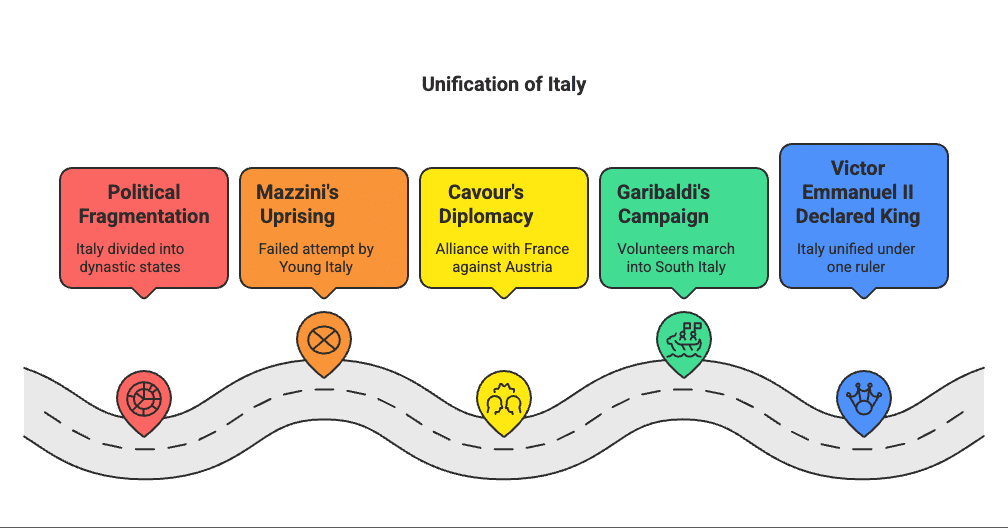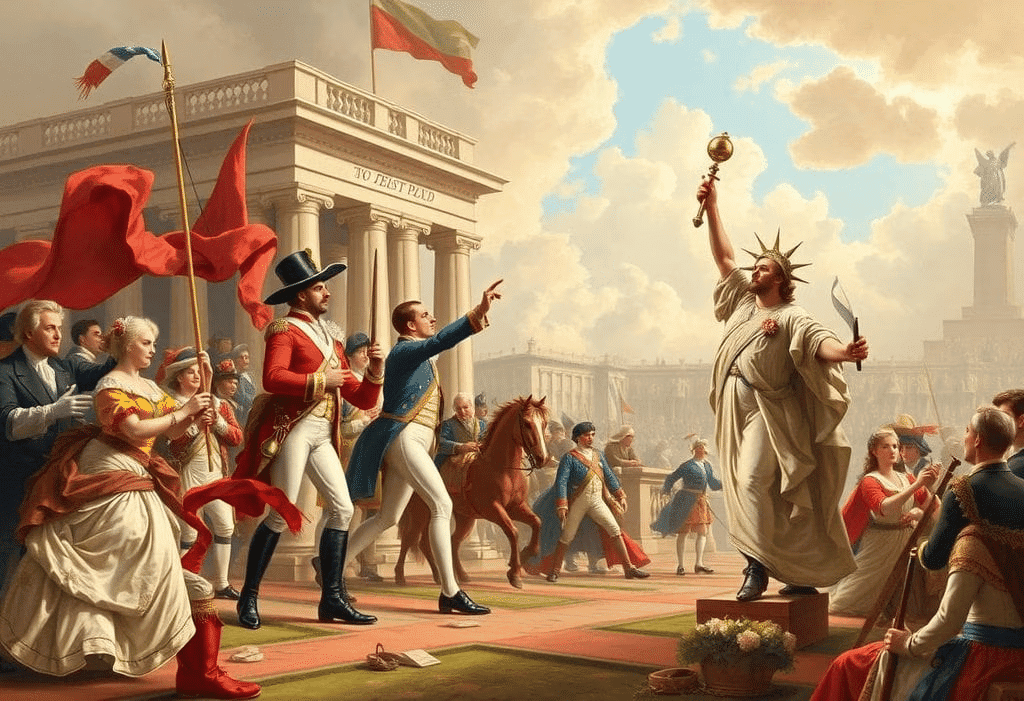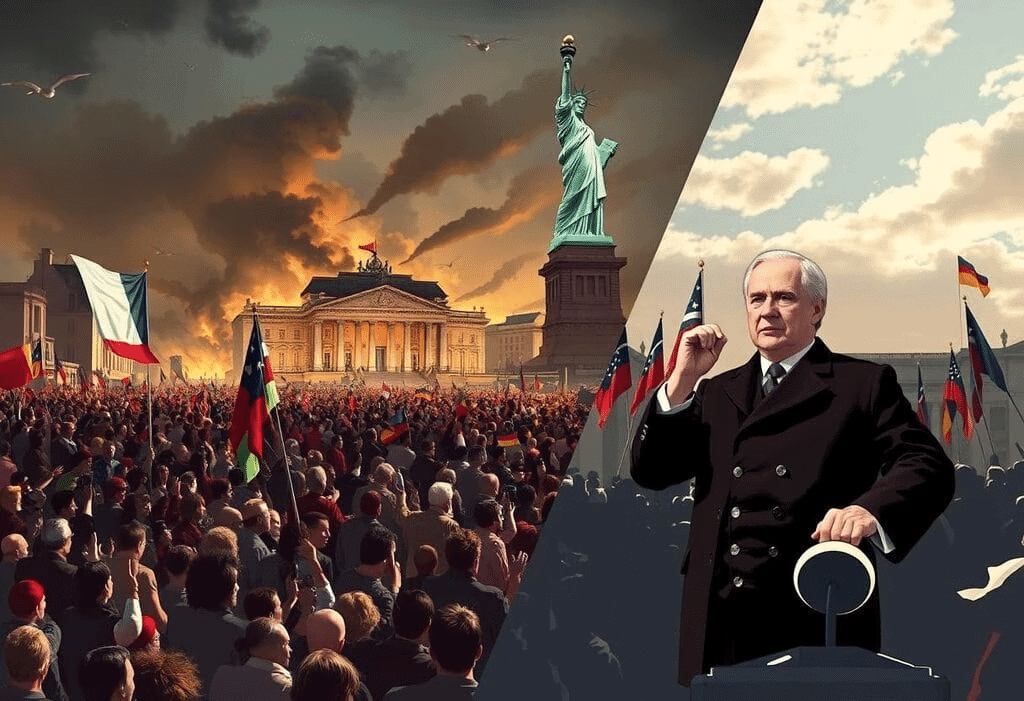Sure Shot Questions for Board Exams: The Rise of Nationalism in Europe | Social Studies (SST) Class 10 PDF Download
Q1: Analyse the process of Italian unification.
 View Answer
View Answer 
Ans: Italy was unified after numerous struggles and movements as described below:
(1) Italy had a long history of political fragmentation among various dynastic states. Sardinia-Piedmont was the only one of seven states ruled by an Italian princely house.
(2) Other regions were ruled by non-Italian rulers. The Italian language had multiple regional and local variations.
(3) In 1830, Giuseppe Mazzini established a secret society called Young Italy and tried to bring about a revolutionary uprising but failed. Thereafter, war was the only resort left.
(4) Chief Minister Cavour led the movement of unification and diplomatically joined Sardinia-Piedmont, in an alliance with France after defeating the Austrian forces in 1859.
(5) Armed volunteers led by Giuseppe Garibaldi also supported the troops and they marched into South Italy and the Kingdom of Two Sicilies. They were supported by peasants in driving out Spanish rulers.
(6) After continuous struggles, Victor Emmanuel II was finally declared the king of unified Italy in 1861.
Q2: Analyse the process of German unification.
 View Answer
View Answer 
Ans: The process of nation state building in Germany took place in the following manner:
(1) Nationalist feelings were widespread among middle class Germans who tried to unite the different regions of the German confederation into a nation state governed by an elected parliament.
(2) This liberal movement faced repression from the monarchy and military, supported by the large landowners known as Junkers.
(3) Prussia took on the leadership of the movement for national unification. Its Chief Minister, Otto von Bismarck was the architect of this process, which was carried out with the help of the Prussian Army and bureaucracy.
(4) Over seven years, three wars against Austria, Denmark, and France resulted in Prussian victories, culminating in the unification of Germany.
(5) On 18 January 1871, the Prussian King, William I, was declared the German Emperor in a ceremony at Versailles.
Q3: Explain Romanticism as a cultural movement in Europe.
 View Answer
View Answer 
Ans: Romanticism was a significant cultural movement in Europe that fostered a unique sense of nationalist sentiment. Key features include:
- Focus on emotions and intuition over reason and scientific thought.
- Emphasis on mystical feelings and the collective heritage of nations.
- Influence of artists and poets who celebrated cultural roots and common pasts.
Romanticism played a crucial role in shaping the idea of the nation through art, poetry, and music.
Q4: Explain Frederic Sorrieu's dream in the context of democratic and social republics in France during 1848.
 View Answer
View Answer 
Ans: Frédéric Sorrieu was a French artist who, in 1848, created a series of four prints. These prints depicted his vision of a world composed of democratic and social republics.
- The first print shows people from Europe and America, of all ages and backgrounds, marching towards the Statue of Liberty.
- Liberty is represented as a female figure, holding the torch of Enlightenment and the Charter of the Rights of Man.
- Above them, figures like Christ and angels symbolise fraternity among nations.
- Sorrieu's work reflects the hopes for unity and democracy during a time of significant political change.
Q5: How did the Greek War of Independence mobilize nationalist feelings among the educated elite across Europe? Explain.
 View Answer
View Answer 
Ans: Greek War of Independence mobilized the nationalist feelings in Europe in the following ways:
(i) Greece was viewed as a part of Europe that had been annexed by Ottomans and now needed to be liberated.
(ii) Greece was perceived as the foundation and cradle of civilization in Europe by poets and artists and this led to nationalist consciousness.
(iii) Greek nationalists received support from other Greeks living in exile.
(iv) Many Europeans had a natural sympathy for the ancient Greek civilization.
(v) Europeans and Greek nationalists were against the Muslim Empire.
Q6: “Ideas of national unity in the early nineteenth-century Europe were closely allied to the ideology of liberalism.” Examine the statement.
 View Answer
View Answer 
Ans: The ideas of national unity were closely allied to the ideology of liberalism in Europe during the nineteenth century. This can be asserted by the following statements:
(1) The term liberalism is derived from the Latin word ‘liber’ which means free. Revolutionaries stood for the freedom of individuals and equality of all before the law.
(2) Liberals began a revolution in 1848. They began many national movements pioneered by the educated middle class to fight for the cause of liberty, freedom and unification for their nation.
(3) Politically, the idea of liberalism advocated for a constitutional and represented government through Parliament. Hence, the ideologies of liberalism and nationalism were closely allied.

Q7: Who among the following was the architect of the unification of Germany?
(a) Otto Von Bismarck
(b) William I
(c) Frederick III
(d) William II
 View Answer
View Answer 
Ans: (a)
Otto Von Bismarck was the key figure in the unification of Germany.
- He played a pivotal role in the process, which culminated in 1871.
- Bismarck is often referred to as the architect of German unification.
- His leadership involved strategic wars with Austria, Denmark, and France.
- These conflicts ultimately led to Prussian victories and the formation of the German Empire.
- In January 1871, the Prussian king, William I, was declared the German Emperor at Versailles.
Q8: Who among the following remarked “When France sneezes, the rest of Europe catches cold”?
(a) Lord Byron
(b) Metternich
(c) Johann Herder
(d) Napoleon
 View Answer
View Answer 
Ans: (b)
Metternich remarked, "When France sneezes, the rest of Europe catches cold." This statement followed the July Revolution in France, which ignited uprisings in various parts of Europe.
- The revolution led to the establishment of a constitutional monarchy with Louis Philippe as its head.
- It also sparked a rebellion in Brussels, contributing to Belgium's independence from the Netherlands.
Q9: Describe the major outcomes of the French Revolution of 1789.
 View Answer
View Answer 
Ans: The major outcomes of the French Revolution of 1789 are as follows:
- It resulted in the transfer of power from King Louis XVI to the National Assembly.
- A collective identity of the people developed.
- The Estate General was elected by the body of active citizens and renamed the National Assembly.
- Jacobin clubs were set up for the propagation of liberal thoughts.
- A new French Flag, the tricolour, was chosen to replace the former royal standard.
- Regional dialects were discouraged and French became the common language of the nation.

Q10: There are two statements marked as Assertion (A) and Reason (R). Mark your answer as per the codes provided below:
(a) Both (A) and (R) are true and (R) is the correct explanation of (A).
(b) Both (A) and (R) are true but (R) is not the correct explanation of (A).
(c) (A) is correct but (R) is wrong.
(d) (A) is wrong but (R) is correct.
Assertion (A): On Prussian initiative 'Zollverein' Custom Union was formed.
Reason (R): It was to create unified economic territory allowing the unhindered movement of goods, people and capital.
 View Answer
View Answer 
Ans: (a)
Assertion (A): On Prussian initiative 'Zollverein' Customs Union was formed.
This statement is true. The Zollverein was indeed initiated by Prussia in the early 19th century, with the purpose of consolidating the fragmented German states economically.
Reason (R): It was to create a unified economic territory allowing the unhindered movement of goods, people, and capital.
This statement is also true. The primary aim of the Zollverein was to eliminate internal tariffs and barriers among the German states, fostering an integrated economic zone where goods, people, and capital could move freely. This economic integration was seen as a step toward political unity in Germany.
Since both statements are true and the reason correctly explains the purpose behind the formation of the Zollverein Customs Union, the correct answer is (a): Both (A) and (R) are true, and (R) is the correct explanation of (A).
Q11: Two statements are given below. They are Assertion (A) and Reason (R). Read both the statements and choose the correct option. (CBSE 2024)
Assertion (A): The most serious source of nationalist tension in Europe after 1871 was Balkan.
Reason (R): A large part of the Balkan was under the control of Ottoman Empire.
(a) Both, (A) and (R) are true and (R) is the correct explanation of (A).
(b) Both, (A) and (R) are true but (R) is not the correct explanation of (A).
(c) (A) is true but (R) is false.
(d) (A) is false but (R) is true.
 View Answer
View Answer 
Ans: (a) Both (A) and (R) are true and (R) is correct explanation of (A).
- Assertion (A): The most serious source of nationalist tension in Europe after 1871 was the Balkans. This is true because the Balkans were a region of intense nationalist movements and conflicts, particularly between the different ethnic groups and empires.
- Reason (R): A large part of the Balkans was under the control of the Ottoman Empire. This is also true. The Ottoman Empire controlled much of the Balkan region, which contributed to nationalist tensions as various groups in the Balkans sought independence or autonomy.
The reason correctly explains the assertion, as the control of the Ottoman Empire over the Balkans was one of the key factors that led to nationalist tensions.
|
66 videos|614 docs|79 tests
|
FAQs on Sure Shot Questions for Board Exams: The Rise of Nationalism in Europe - Social Studies (SST) Class 10
| 1. What were the main factors that contributed to the rise of nationalism in Europe during the 19th century? |  |
| 2. How did the French Revolution influence nationalist movements across Europe? |  |
| 3. What role did the unification of Italy and Germany play in the spread of nationalism? |  |
| 4. What impact did the decline of empires have on the rise of nationalism in Europe? |  |
| 5. How did cultural factors contribute to the rise of nationalism in Europe? |  |

















